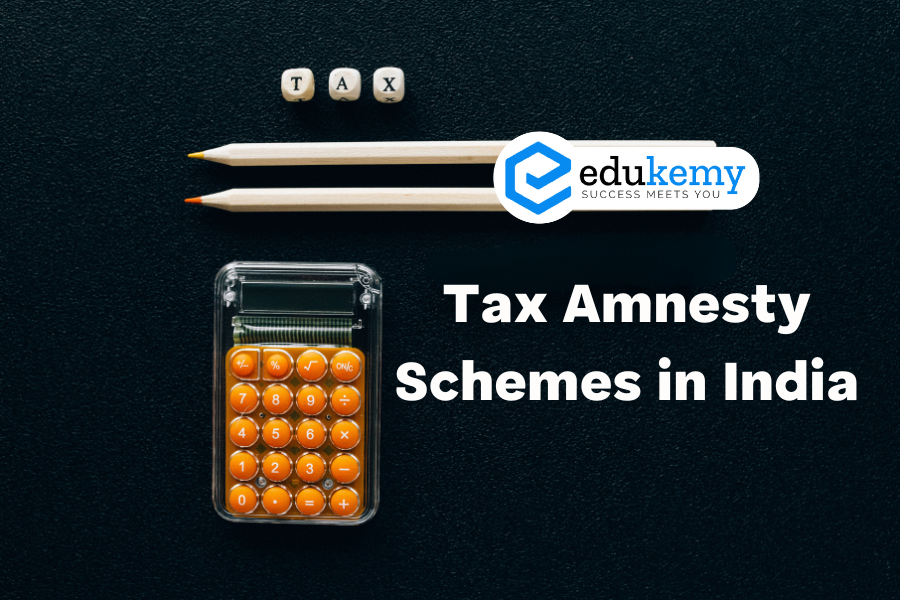
Tax amnesty schemes in India, also known as voluntary disclosure or amnesty schemes, have been periodically introduced by the government to provide taxpayers with an opportunity to declare their undisclosed income and assets, and to pay taxes on them without facing any penalties or prosecution. These schemes aim to widen the tax base, increase compliance, and generate revenue for the government. Over the years, several tax amnesty schemes have been implemented, each with its own set of rules, objectives, and outcomes, impacting the Indian economy and tax administration landscape.
Contents
- 1 Tax Amnesty Schemes in India:
- 2 FAQs
- 2.1 Q: What is a tax amnesty scheme in India?
- 2.2 Q: What are the objectives of tax amnesty schemes in India?
- 2.3 Q: How does a tax amnesty scheme work in India?
- 2.4 Q: Are there any disadvantages to participating in a tax amnesty scheme in India?
- 2.5 Q: What are some recent examples of tax amnesty schemes in India?
- 3 In case you still have your doubts, contact us on 9811333901.
Tax Amnesty Schemes in India:
1. Income Declaration Scheme (IDS 2016):
- Launched in 2016 as part of the union budget.
- Aimed at unearthing black money and bringing it into the formal system.
- Provided an opportunity for income tax and wealth tax defaulters to declare their assets, pay taxes, and a penalty to avoid litigation.
- Allowed individuals to come clean by disclosing their undisclosed income and assets.
2. Pradhan Mantri Garib Kalyan Yojana, 2016 (PMGKY):
- Launched in December 2016, following the IDS.
- Provided an opportunity for individuals to declare unaccounted wealth and black money in a confidential manner.
- Allowed individuals to avoid prosecution by paying taxes, interest, and fines.
- Aims to bring undisclosed wealth into the formal economy.
3. Sabka Vishwas-Legacy Dispute Resolution Scheme:
- Operational from 1st September 2019.
- Announced in the 2019-2020 Union Budget.
- Targeted legacy tax disputes related to service tax and excise duty before the implementation of GST.
- Aimed to free taxpayers from legacy tax issues.
- Components include amnesty and dispute resolution.
- Provided relief in tax dues with a full waiver of interest, fines, and penalties.
- Offered complete amnesty from prosecution.
- Provided relief of varying amounts based on the nature of the case.
Overall Impact:
- Tax amnesty schemes provide an opportunity for individuals to rectify their tax non-compliance and declare undisclosed income/assets.
- Encourage individuals to come forward, pay taxes, and contribute to the formal economy.
- Aims to reduce tax evasion, bring black money into the mainstream, and resolve legacy tax disputes.
Operation Clean Money 1 and 2:
- Operation Clean Money 1 (2017):
- Initiated by the Income Tax Department (ITD) in 2017.
- Involved the e-verification of large cash deposits made post-demonetization in 2016.
- Used data analytics to compare demonetization data with information in ITD databases.
- Identified individuals with cash transactions inconsistent with their taxpayer profiles.
- Information from banks was used to identify persons with inconsistent tax profiles based on their cash deposits during demonetization.
- Aimed to ensure compliance and identify individuals evading taxes.
- Operation Clean Money 2:
- Generally, subsequent operations build on the initiatives of the previous ones to enhance tax compliance and address tax evasion issues.
Vivad se Vishwas:
- Introduced in the 2020-21 union budget.
- Aims to provide relief to taxpayers involved in tax disputes.
- Taxpayers who pay the disputed tax within a specified period are granted a complete waiver of interest and penalties.
- Seeks to resolve tax disputes and encourage taxpayers to come forward and settle their tax matters.
FAQs
Q: What is a tax amnesty scheme in India?
A: A tax amnesty scheme in India is a government initiative aimed at granting taxpayers a limited-time opportunity to declare undisclosed income or assets and pay taxes on them with reduced penalties or immunity from prosecution.
Q: What are the objectives of tax amnesty schemes in India?
A: Tax amnesty schemes in India are typically introduced to encourage voluntary compliance, widen the tax base, unearth black money, and generate revenue for the government.
Q: How does a tax amnesty scheme work in India?
A: During a tax amnesty scheme, taxpayers are given a specified period to voluntarily disclose their undisclosed income or assets. They are required to pay taxes on the declared amount, often at a reduced rate, and may be granted immunity from penalties or prosecution.
Q: Are there any disadvantages to participating in a tax amnesty scheme in India?
A: While tax amnesty schemes offer certain benefits, such as reduced penalties and immunity from prosecution, taxpayers who participate may still face scrutiny from tax authorities. Additionally, there could be reputational risks associated with admitting to undisclosed income or assets.
Q: What are some recent examples of tax amnesty schemes in India?
A: Recent tax amnesty schemes in India include the Pradhan Mantri Garib Kalyan Yojana (PMGKY) launched in 2016 and the Sabka Vishwas (Legacy Dispute Resolution) Scheme introduced in 2019. These schemes aimed to provide relief to taxpayers by offering reduced tax rates and penalties for the declaration of undisclosed income and assets.
In case you still have your doubts, contact us on 9811333901.
For UPSC Prelims Resources, Click here
For Daily Updates and Study Material:
Join our Telegram Channel – Edukemy for IAS
- 1. Learn through Videos – here
- 2. Be Exam Ready by Practicing Daily MCQs – here
- 3. Daily Newsletter – Get all your Current Affairs Covered – here
- 4. Mains Answer Writing Practice – here

